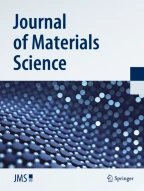Abstract
Thermal cycling of an epoxy coating on silicon through the glass transition temperature (T g) revealed a large stress hysteresis on the first thermal cycle through T g and a change in the stress–temperature slope at T g resulting from the change in the epoxy elastic properties due to the glass transition. This stress hysteresis was not observed on subsequent thermal cycles through T g. However, after the coating was annealed (aged) below T g (for hours or longer)—during which the stress relaxed exponentially with time—the stress hysteresis returned. The magnitude of stress hysteresis, on cycling through T g, was found to correlate to the magnitude of long-time relaxation that occurred during annealing at temperatures below T g.
Similar content being viewed by others
Explore related subjects
Discover the latest articles, news and stories from top researchers in related subjects.References
Cherepanov GP (1995) J Appl Phys 78:6826
Kuczynski J, Sinha AK (2001) IBM J Res Dev 45:783
Teh LK, Anto E, Wong CC, Mhaisalkar SG, Wong EH, Teo PS, Chen Z (2004) Thin Solid Films 462–463:446
Ernst LJ, Zhang GQ, Jansen KMB, Bressers HJL (2003) J Electron Packaging 125:539
Koguchi H, Sasaki C, Nishida K (2003) J Electron Packaging 125:414
Meuwissen MHH, De Boer HA, Steijvers HLAH, Schreurs PJG, Geers MGD (2004) Microelectron Reliab 44:1985
Stevens JR, Ivey DG (1958) J Appl Phys 29:1390
Kim JS, Paik KW, Seo SH (1999) J Appl Phys 86:5474
Zhao J-H, Kiene M, Hu C, Ho P (2000) Appl Phys Lett 77:2843
Que L, Gianchandani YB (2000) J Vac Sci Technol B 18:3450
Perera DY, Schutyser P (1994) Progr Org Coat 24:299
Perera DY (2002) Progr Org Coat 44:55
Perera DY (2003) Progr Org Coat 47:61
Chang W-J, Fang T-H, Lin C-M (2005) J Appl Phys 97:103521
Montserrat S, Gomez Ribelles JL, Meseguer JM (1998) Polymer 39:3801
Cook WD, Mehrabi M, Edward GH (1999) Polymer 40:1209
Montserrat S (1994) J Polym Phys B 32:509
Montserrat S (2000) J Polym Phys B 38:2272
Timoshenko S (1925) J Opt Soc Am 11:233
Corcoran EM (1969) J Paint Technol 41:635
Brantley WA (1973) J Appl Phys 44:534
Yan G, White JR (1999) Polym Eng Sci 39:1856
Gaynor JF, Desu SB (1994) J Mat Sci Lett 13:236
Shen JJ, Shao Z, Li S (1995) Polymer 36:3479
Voloshin S, Tsao P-H, Pearson RA (1998) J Electron Packaging 120:314
Fesko DG (2000) Polymer Eng Sci 40:1495
Freund LB, Floro JA, Chason E (1999) Appl Phys Lett 74:1987
Acknowledgement
The author (JT) acknowledges Awirut Maglai for assistance with sample preparation and Bob Matz for helpful discussions.
Author information
Authors and Affiliations
Corresponding author
Appendix A: Non-linear deformation analysis
Appendix A: Non-linear deformation analysis
The use of Eq. 1 requires that the strains and rotations in the system be infinitesimally small. This requirement was examined using the analysis of Freund et al. [27], who showed that non-linear deformation effects can be avoided if the dimensionless parameters S or K are less than 0.3–0.4 or 0.2, respectively:
and
where ε m is the imposed thermal mismatch strain, R is the sample radius (50 mm), E f is the film Young’s Modulus, and ν is the film Poisson’s Ratio. Since the film mechanical properties are not known, the parameter K was evaluated using the largest change in curvature observed over the course of the experiment, Δκ = 0.02 m−1, to be K = 0.016. As K < 0.2, non-linear deformations were not considered.
Rights and permissions
About this article
Cite this article
Thurn, J., Hermel-Davidock, T. Thermal stress hysteresis and stress relaxation in an epoxy film. J Mater Sci 42, 5686–5691 (2007). https://doi.org/10.1007/s10853-006-0654-y
Received:
Accepted:
Published:
Issue Date:
DOI: https://doi.org/10.1007/s10853-006-0654-y
